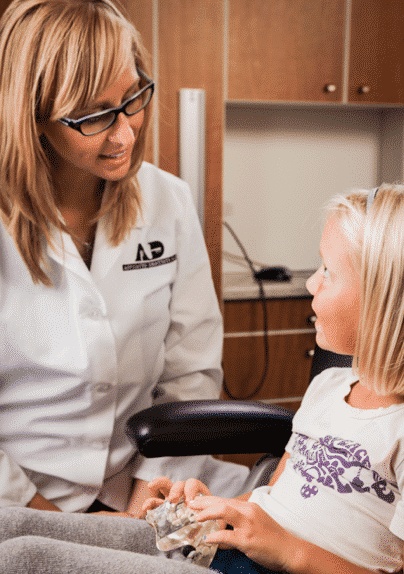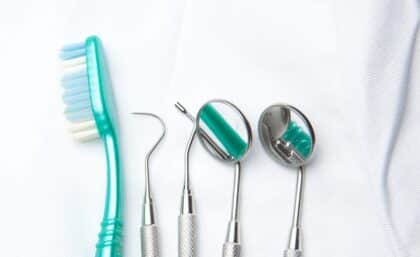The Dental Profession
Who are your dental professionals? Dentists are the most well known, but what is a dentist, really? How are they trained? Why does your dentist have a nurse? Is that person a nurse? And what is the deal with the person actually cleaning your teeth? Dentists, dental assistants and dental hygienists all receive different educations and work within specific aspects of the dental profession.

What is a dentist?
A dentist is defined as a practitioner who specializes in the diagnosis, prevention and treatment of diseases and conditions of the mouth. Dentists can be responsible for dental treatments such as restorations (fillings, crowns and implants), orthodontics, prosthetics, endodontic therapy, periodontal therapy and simple exodontia (extraction of teeth) as well as performing examinations, taking radiographs and diagnosis. But this doesn’t mean all dentists perform these treatments. Orthodontics, endodontics, periodontics and exodontia tend to be a specialty for most dentists. They may require additional training, specific instruments and equipment, and in the Madison, Wisconsin market specifically, most general dentists tend to refer patients out to these specialist dentists to ensure the highest quality of care.
Professions involving oral and maxillofacial surgery requires further training and qualifications before a dentist can perform oral surgery. Oral surgery can be different from a simple extraction depending on the situation in which the tooth is being extracted.

“I became a dentist because I saw a career where I could help people and have the ability to run my own business,” Dr. John Busby said. “Unfortunately teenagers and young adults can have accidents and damage their teeth, and I recognize this can cause them self-esteem problems as they get older. Although it is challenging, the satisfaction of seeing a smile reclaimed and the joy of the person feeling ‘back to normal’ or better is the most rewarding for me.”
What is a dental assistant?
Simply put, the dental assistant assists the dentist during treatments. It’s a simple description for a complicated job. Dental assistants help the dentist provide more efficient dental treatment by preparing the patient for the procedures. They are in charge of sterilizing and keeping track of the instruments and equipment, passing instruments during the procedure, holding the suction device, taking and making sure the dentist has the proper radiographs for the specified procedure, taking impressions and fabricating provisional crowns. Dental assistants are another set of steady hands for the dentist to rely on during procedures.

It’s true in many states of the U.S. (Wisconsin included) dental assistants are not required to be licensed or certified for their position. Most dental assistants nowadays receive a basic college degree from a community college or vocational school but gain a significant amount of their education hands-on in the field. Back in the 60s, 70s and even in the 80s it was common for small dental offices to hire an assistant who may only have office skills. It’s more common now for dental assistant to interview specifically for the assistant position.
What is a dental hygienist?
“Becoming a dental hygienist gave me the freedom to build a one-on-one relationship with my patients,” dental hygienist Jackie Page said. “The biggest reward in hygiene for me is being able to enhance a patient’s overall health by educating them about proper dental care.”
A dental hygienist is a licensed dental professional who specializes in preventative oral hygiene. Dental hygienists provide three types of services to their patients: preventative services to promote and maintain good oral health, educational services to help patients develop behaviors that promote good oral health and help them understand the importance of practicing these behaviors and therapeutic treatments meant to stop disease and maintain healthy tissues in the mouth. Common procedures performed by dental hygienists include cleanings known as prophylaxis, scaling and root planing for patients with periodontal disease, the taking of radiographs (x-rays), dental sealants, administering of fluoride and providing instruction for proper oral hygiene and care. Hygienists work with a dentist to create a co-therapist environment. They also provide dental hygiene diagnosis, which helps them decide on the best hygienic treatment for the individual patient.

A dental hygienist has 5 steps in their dental care process:
- Accessing the patient – this includes but is not limited to a review of the patients medical history, taking necessary x-rays, clinical examination and a periodontal assessment. The hygienist will thoroughly document their findings as they go through this stage.
- Dental hygiene diagnosis – assessing of data pertaining to the patient’s condition, identifying problems and discussing potential treatment options with the dentist and patient.
- Planning – creating a treatment plan for the patient, and keeping track of progress to alter treatments as needed.
- Implementation – carrying out the treatment plan, timely and effectively.
- Evaluation – determining the effectiveness of the treatment plan. If the treatment plan is deemed ineffective, a complete re-evaluation will be done to determine a better option.
What is the education process for these professions?
A student interested in becoming a dentist must first graduate college with a minimum of a bachelor’s degree with credits in general biology, general chemistry, organic chemistry, physics and statistics/calculus. Once that is achieved, the student must then apply to a dental school, and in order to do that, they must take the Dental Admissions Test (DAT). The DAT is a multiple choice computer-based exam. Admissions to dental school is highly competitive and is determined by factors such as GPA, DAT scores, recommendation letters and extracurricular activities.
Getting a dental license.
Upon completion of an accredited dental school’s curriculum and successfully mastering all clinical competencies and national board exams, a student may then receive his/her license to practice dentistry. There are some states that require the student to complete a post graduate residency program. Newly graduated students are awarded with a Doctor of Dental Surgery (DDS) or Doctor of Dental Medicine (DMD). These two degrees are the same, it just depends on which school the student attended.
Education doesn’t stop with graduation.
Even after graduation, and entering into their desired profession, dentists continue their education through attending lectures to learn of new procedures, new methods of treatment and new technologies and instruments. Dentists are required by state and federal laws to attend a certain amount of continuing education hours. Also, a dentist who continues his/her education and training tends to be better prepared to handle a variety of cases and surprises that may come up when treating a patient.
“Since I am a third generation dentist, I understood the life of a dentist well,” Dr. Mark Gustavson said. “I chose dentistry in college because I wanted to treat people, but still work with my hands. Everyday I get a fix it project or get to make a tooth sculpture. I get the most enjoyment out of dentistry a couple years after the work is done. I will have small moments when I realized that a patient would no longer have teeth if it was not for my care.”

The educational process to become a dental assistant or a hygienist.
Students who wants to be a dental assistant is required to have a high school degree, however in many states it is not required they graduate from college, be licensed or certified. If a person does wish to seek higher education for their profession, they can attend accredited dental assisting school programs, of which there are over 200 in the United States. Most of a dental assistant’s education comes from a hands-on approach.
Dental hygienists must be graduates from a dental hygiene college program with either an associates degree (most common), a certificate, a bachelor’s degree or a master’s degree from a school accredited by the American Dental Association. The student must complete a minimum of 2 years of school and pass a written board as well as a clinical board exam. Dental hygienist school programs usually require both general education courses including college level algebra, biology and chemistry and course specific to the field of dental hygiene including anatomy, oral anatomy, materials science, radiology and clinical skills.
A trusting relationship.
Dentistry is one of the oldest medical professions. It’s also a profession that requires a great amount of trust between patient and dental professional. Patients need to trust that their hygienists, dental assistants and dentists strive to be on top of all the up-to-date methods for diagnosis and treatments for their individual care. And hygienists, dental assistants and dentists need to trust that their patients know their dental professional is there for their health and happiness. For this reason, it is very important to keep a regular schedule of exams and cleanings with your dentist and hygienist.
“I became a dentist to be a part of the community and to help people feel more confident about their smile, whether it’s through a large change or a much smaller one,” Dr. Brian Porter said. “My favorite experience was receiving a bear-hug from a patient that had just completed her treatment and the excitement in her eyes to see herself smiling again.”
